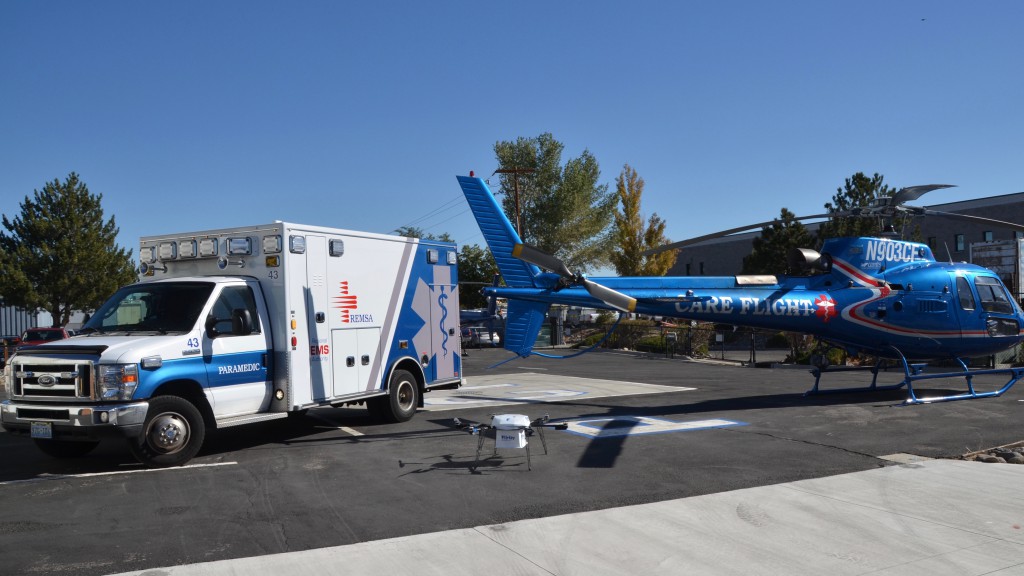Defibrillator Drones Aim to Respond in 911 Calls
Posted on Categories Discover Magazine

By 2018, Flirtey drones could begin delivering defibrillators to help speed aid to victims of cardiac arrest. Credit: Andi Kilgore | Flirtey Inc.
Delivery drones carrying defibrillators could begin swooping in to save American victims of cardiac arrest starting in 2018. A new partnership between a delivery drone startup and an emergency medical services provider aims to dispatch defibrillator drones ahead of ambulances in response to 911 calls made in northern Nevada.
Using drones to deliver life-saving automatic external defibrillators for restarting victims’ hearts could have a huge impact. Cardiac arrest represents the leading cause of natural death in the United States with more than 350,000 out-of-hospital cases each year–and the odds of survival drop by about 10 percent for every minute that goes by in cardiac arrest cases. Having defibrillator drones on call could go a long way toward improving survival rates for out-of-hospital cardiac arrests that hovered around just 12 percent in 2016.
“The public use case is really strong, because if we don’t send a defibrillator drone there is basically a 90 percent chance [the cardiac arrest victim] will die,” says Matt Sweeney, CEO of the delivery drone startup Flirtey. “If we do send it, there is a significantly increased likelihood of survival.”
The startup has teamed up on its defibrillator drone effort with REMSA, a not-for-profit emergency medical services system that operates both ground ambulances and an air ambulance service with airplanes and helicopters. Their vision is for Flirtey to keep a number of defibrillator drones standing by at certain store locations where Flirtey is already operating delivery drone services. Those defibrillator drones could then take off whenever a family member or bystander calls 911 about a cardiac arrest victim and ideally arrive on the scene within five minutes.

Flirtey has partnered with a Nevada-based emergency services organization to enable delivery drones to respond to 9-11 calls ahead of ambulances. Credit: Andi Kilgore | Flirtey Inc.
Flirtey’s defibrillator drones would use GPS to find their way based on the given address and the location of the 911 callers, Sweeney says. Once a drone lands, the 911 operator could talk the caller through the process of using the defibrillator on the cardiac arrest victim–a process that can be done even with untrained bystanders.
The idea of drones shaving precious minutes off emergency response times has already undergone a preliminary trial run in Sweden during October 2016. Drones dispatched from a fire station showed that they could quickly fly to nearby locations within a 6.2 mile radius where cardiac arrest cases had previously occurred. Their median response times were about 16 minutes faster than how long it had taken ambulances to previously reach the same locations.
In the case of Flirtey’s effort, Sweeney sounds optimistic about getting government regulators from the Federal Aviation Administration (FAA) to sign off on the defibrillator drone effort. That’s in part because Flirtey’s partner, REMSA, already operates an air ambulance service involving both aircraft and helicopters. But Flirtey itself also has plenty of experience in working with FAA regulators on prior delivery drone tests.
“We’re now working together to get regulatory approval to open the skies for defibrillator drones,” Sweeney says. “I would expect first delivery sometime in 2018.”
Flirtey notably made headlines for its attempts to launch commercial delivery drone services in partnership with Domino’s Pizza and 7-Eleven convenience stores. But the startup has also done plenty to show how delivery drones can “save lives” in addition to “change lifestyles,” as Sweeney described it. Back in 2015, Flirtey carried out the first drone delivery of medical packages approved by the U.S. Federal Aviation Administration to a rural health clinic in Virginia. In 2016, Flirtey experimented with delivering emergency supplies to the doorstep of a Nevada home and conducted a ship-to-shore demonstration of involving delivery of medical samples and supplies.